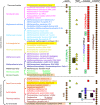Comparative genomics guided discovery of two missing archaeal enzyme families involved in the biosynthesis of the pterin moiety of tetrahydromethanopterin and tetrahydrofolate
- PMID: 22931285
- PMCID: PMC3500442
- DOI: 10.1021/cb300342u
Comparative genomics guided discovery of two missing archaeal enzyme families involved in the biosynthesis of the pterin moiety of tetrahydromethanopterin and tetrahydrofolate
Abstract
C-1 carriers are essential cofactors in all domains of life, and in Archaea, these can be derivatives of tetrahydromethanopterin (H(4)-MPT) or tetrahydrofolate (H(4)-folate). Their synthesis requires 6-hydroxymethyl-7,8-dihydropterin diphosphate (6-HMDP) as the precursor, but the nature of pathways that lead to its formation were unknown until the recent discovery of the GTP cyclohydrolase IB/MptA family that catalyzes the first step, the conversion of GTP to dihydroneopterin 2',3'-cyclic phosphate or 7,8-dihydroneopterin triphosphate [El Yacoubi, B.; et al. (2006) J. Biol. Chem., 281, 37586-37593 and Grochowski, L. L.; et al. (2007) Biochemistry46, 6658-6667]. Using a combination of comparative genomics analyses, heterologous complementation tests, and in vitro assays, we show that the archaeal protein families COG2098 and COG1634 specify two of the missing 6-HMDP synthesis enzymes. Members of the COG2098 family catalyze the formation of 6-hydroxymethyl-7,8-dihydropterin from 7,8-dihydroneopterin, while members of the COG1634 family catalyze the formation of 6-HMDP from 6-hydroxymethyl-7,8-dihydropterin. The discovery of these missing genes solves a long-standing mystery and provides novel examples of convergent evolutions where proteins of dissimilar architectures perform the same biochemical function.
Figures




Similar articles
-
Functional promiscuity of the COG0720 family.ACS Chem Biol. 2012 Jan 20;7(1):197-209. doi: 10.1021/cb200329f. Epub 2011 Oct 26. ACS Chem Biol. 2012. PMID: 21999246 Free PMC article.
-
An Fe2+-dependent cyclic phosphodiesterase catalyzes the hydrolysis of 7,8-dihydro-D-neopterin 2',3'-cyclic phosphate in methanopterin biosynthesis.Biochemistry. 2009 Oct 13;48(40):9384-92. doi: 10.1021/bi9010336. Biochemistry. 2009. PMID: 19746965
-
Characterization of an Fe(2+)-dependent archaeal-specific GTP cyclohydrolase, MptA, from Methanocaldococcus jannaschii.Biochemistry. 2007 Jun 5;46(22):6658-67. doi: 10.1021/bi700052a. Epub 2007 May 12. Biochemistry. 2007. PMID: 17497938
-
Tetrahydrofolate and tetrahydromethanopterin compared: functionally distinct carriers in C1 metabolism.Biochem J. 2000 Sep 15;350 Pt 3(Pt 3):609-29. Biochem J. 2000. PMID: 10970772 Free PMC article. Review.
-
Unusual pathways and enzymes of central carbohydrate metabolism in Archaea.Curr Opin Microbiol. 2005 Dec;8(6):695-705. doi: 10.1016/j.mib.2005.10.014. Epub 2005 Oct 26. Curr Opin Microbiol. 2005. PMID: 16256419 Review.
Cited by
-
Variations in metabolic pathways create challenges for automated metabolic reconstructions: Examples from the tetrahydrofolate synthesis pathway.Comput Struct Biotechnol J. 2014 Jun 11;10(16):41-50. doi: 10.1016/j.csbj.2014.05.008. eCollection 2014 Jun. Comput Struct Biotechnol J. 2014. PMID: 25210598 Free PMC article. Review.
-
Structure of dihydromethanopterin reductase, a cubic protein cage for redox transfer.J Biol Chem. 2014 Mar 28;289(13):8852-64. doi: 10.1074/jbc.M113.522342. Epub 2014 Feb 12. J Biol Chem. 2014. PMID: 24523405 Free PMC article.
-
Biological, dietetic and pharmacological properties of vitamin B9.NPJ Sci Food. 2025 Mar 13;9(1):30. doi: 10.1038/s41538-025-00396-w. NPJ Sci Food. 2025. PMID: 40075081 Free PMC article. Review.
-
Systematic genome assessment of B-vitamin biosynthesis suggests co-operation among gut microbes.Front Genet. 2015 Apr 20;6:148. doi: 10.3389/fgene.2015.00148. eCollection 2015. Front Genet. 2015. PMID: 25941533 Free PMC article.
-
Four families of folate-independent methionine synthases.PLoS Genet. 2021 Feb 3;17(2):e1009342. doi: 10.1371/journal.pgen.1009342. eCollection 2021 Feb. PLoS Genet. 2021. PMID: 33534785 Free PMC article.
References
-
- Overbeek R.; Begley T.; Butler R. M.; Choudhuri J. V.; Chuang H. Y.; Cohoon M.; de Crécy-Lagard V.; Diaz N.; Disz T.; Edwards R.; Fonstein M.; Frank E. D.; Gerdes S.; Glass E. M.; Goesmann A.; Hanson A.; Iwata-Reuyl D.; Jensen R.; Jamshidi N.; Krause L.; Kubal M.; Larsen N.; Linke B.; McHardy A. C.; Meyer F.; Neuweger H.; Olsen G.; Olson R.; Osterman A.; Portnoy V.; Pusch G. D.; Rodionov D. A.; Ruckert C.; Steiner J.; Stevens R.; Thiele I.; Vassieva O.; Ye Y.; Zagnitko O.; Vonstein V. (2005) The subsystems approach to genome annotation and its use in the project to annotate 1000 genomes. Nucleic Acids Res. 33, 5691–5702. - PMC - PubMed
-
- Henry C. S.; Overbeek R.; Xia F.; Best A. A.; Glass E.; Gilbert J.; Larsen P.; Edwards R.; Disz T.; Meyer F.; Vonstein V.; DeJongh M.; Bartels D.; Desai N.; D’Souza M.; Devoid S.; Keegan K. P.; Olson R.; Wilke A.; Wilkening J.; Stevens R. L. (2011) Connecting genotype to phenotype in the era of high-throughput sequencing. Biochim. Biophys. Acta 1810, 967–977. - PubMed
Publication types
MeSH terms
Substances
Grants and funding
LinkOut - more resources
Full Text Sources
Molecular Biology Databases

